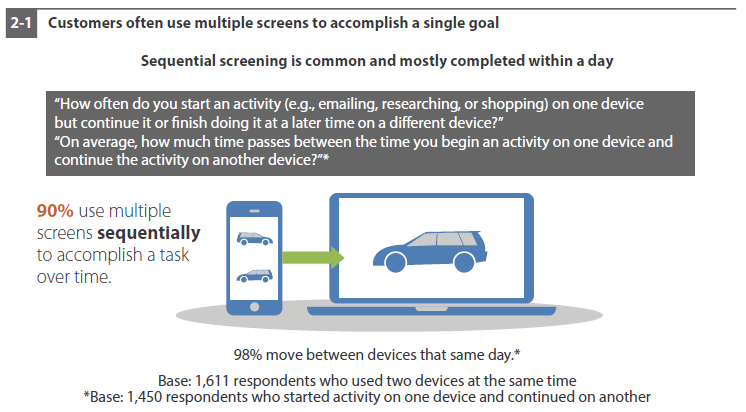I currently own, and regularly use, a Samsung smartphone, Apple iPad, and Asus laptop computer. I use more social media channels than are good for me. I’ll start a conversation on one channel, finish it on another, and do this from any device. Apparently, I’m far from the only one who works this way, judging by the latest Forrester research. Here’s the relevant screenshot, from that research report:
How I work
Forrester’s research is only part of the picture. Sure, I start a blog post in Google Docs, from my iPad, and finish it on my laptop. And, I’ll send off a tweet from my laptop, and get notifications related to it sent to my smartphone. And, I collaborate in the cloud with others, on a document, and then reply to an email about it, via my smartphone.
I’m also, though, carrying on conversations that aren’t being followed up on. They start, e.g., on Twitter, and end on Twitter. They start on a blog, in email… and end there. Yet, those conversations are with the same people, on the same topic. And, what happens when that person is your client, too? Where’s the value-add?
The conversation is everywhere
The 90% use multiple screens data reminds me of something we, as facilitators, mediators, and active participants in virtual domains, need to get a better handle on; choreographing conversations across communication channels.
No matter our line of service work, relationships come first. And when facilitating change is part of our business, whether its individual or organizational, its conversations that constitute the relationship, and drive the change. What’s the chances that all those conversations will be nicely packaged in one communications channel? How about zero!
Getting it together?
One of the skills we are going to need going forward, is to gain fluency in multiple channels, and have a way of connecting, running a thread through, those conversations. We need to do that for clients and customers, to show them they are in charge.
And, I think we we need to do it for our sanity, our sense, however delusional, that we have some control over the process. At least, that’s what I tell myself.
Fluidity across mediums. How do we do that, in a world of information and channel ubiquity? It’s one of our greatest challenges, as facilitators, and relationship-based service providers. Agreed?


Speak Your Mind